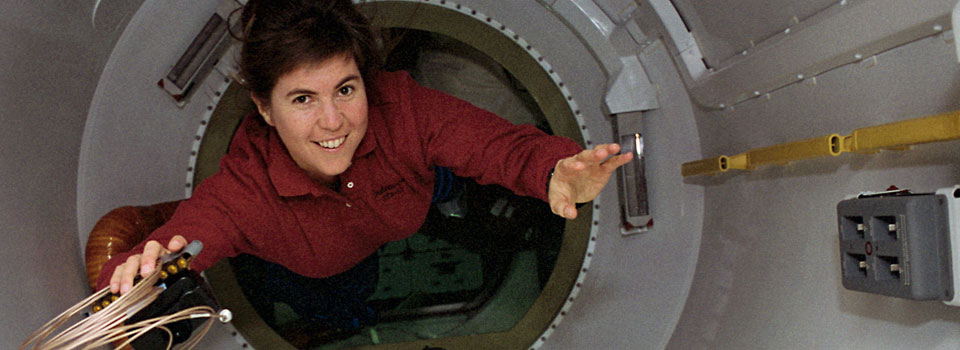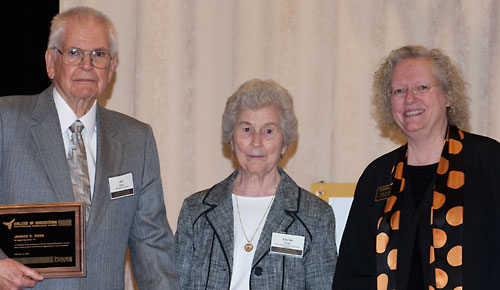Remembering a pioneer in spaceflight
Remembering a pioneer in spaceflight
| Author: | Jeanne Norberg and Della Pacheco |
|---|---|
| Magazine Section: | Always |
| College or School: | CoE |
| Article Type: | Issue Feature |
Voss was interviewed shortly before her death about the future of spaceflight and career advice for Purdue Aeronautics and Astronautics graduates as the shuttle era came to a close.
“The basic principles shouldn’t be any different: Pursue a field you can be an expert in, be a good public speaker, a team player, stay fit, and I’m certain there will be plenty of opportunities to fly in space,” Voss said, calling adaptability a key.
An overall commitment to science and engineering excellence made Voss a standout among 1,945 qualified individuals who applied to NASA’s Astronaut Program for the 1990 class. Purdue’s first female astronaut, Voss had flown in space five times, traveling a total of 18.8 million miles in 779 orbits over 49 days.
What was her biggest thrill about gliding through space? Not so much the view of the globe, but a chance to be part of a stellar team. “It’s an amazing feeling of belonging,” Voss said. “Everyone is working together with the same goals.”
She was asked in a December interview what she thought people would recall about her era in space.
“I think the world will see 2001 as a major turning point in history, the time when our space odyssey took off,” she predicted. “That is when we began having people in space continuously for an entire year, with our shuttle flights and the international space station.”
Voss enjoyed sharing her story as an astronaut to spark an interest in young people about the importance of studying science and math. In 2009, Voss visited the campus, speaking to two sections of a seminar for Women in Engineering first-year students. She also donated personal papers, video and reports to the Purdue Libraries Division of Archives and Special Collections, joining those of astronaut alumni Neil Armstrong, Eugene Cernan and others.
One of those records was a school report card testifying that she was a straight-A math student who also earned top marks for conduct and effort.
It all started with a book
Louise Voss, her mother, said in a New York Times interview that the spark for discovery began when 6-year-old Janice picked up Madeleine L’Engle’s book “A Wrinkle in Time” — a fantasy in which one of the main characters is a scientist who happens to be a woman.
At just 16, Voss entered Purdue majoring in engineering science while working as an intern at NASA. After earning her degree in 1975, she returned to the center to train crews in entry guidance and navigation.
Her ability to adapt to change served her well through a “chaotic” professional development program at the Massachusetts Institute of Technology, where two of her thesis advisors died, two others left the university after not receiving tenure and even a couple of the programs she was accepted to were canceled. Nevertheless, Voss went on to earn a master’s in electrical engineering in 1977, and a doctorate in aeronautics and astronautics in 1987.
She became an astronaut in 1991, one of 23 Purdue graduates NASA has selected for space flight. Her first flight was aboard the STS57 for 10 days in 1993. She later was part of a space mission in 1995, two in 1997 and her last in 2000. The last mission was an 11-day flight during which the international crew aboard shuttle Endeavour mapped more than 47 million square miles of Earth’s land surface.
In her first flight on Endeavour in 1993, Voss supervised 22 experiments in the SPACEHAB, the world’s first commercial laboratory module in space. In 1995 she flew on the shuttle Discovery on a historic NASA mission in which a shuttle rendezvoused with the Russian space station, Mir, for the first time. During the mission, Voss operated Discovery’s robot arm to grasp an astronomy satellite being deployed.
She was payload commander in charge of 33 experiments on Columbia, which went into space twice because of technical problems in 1997. And she served as payload commander again in 2000 during her final flight on Endeavour.
On the ground in recent years at the Johnson Space Center in Houston, Voss oversaw astronauts’ training in conducting experiments in space.
Carrying the mission forward
On Feb. 24 a Celebration of Life was held for family, friends and colleagues in Neil Armstrong Hall of Engineering’s Kurz Atrium. The Voss family has established an engineering scholarship fund in Janice’s name. Memorial gifts may be sent in care of Marcus Knotts, Dauch Alumni Center, 403 W. Wood St., West Lafayette IN 47907.
“Janice was enthusiastic about encouraging all students, but especially women, to consider careers in engineering and science,” said Beth Holloway, director of Purdue’s Women in Engineering Program. “This scholarship will continue that legacy.”
Voss’ parents accepted a posthumous Distinguished Engineering Alumna Award on Feb. 24 in recognition of Janice’s “pioneering and record-setting achievements in the U.S. space program and her commitment to engineering and science education.”


Comments